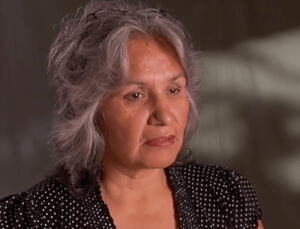
Lorna Rope
St. Paul's Residential School
Lebret, Saskatchewan
Lorna Rope was a residential school student at St. Paul’s or Lebret (Qu’Appelle) Indian Industrial Residential School in Lebret, Saskatchewan. Originally from Carry The Kettle First Nations, Lorna still remembers the emotional farewell by her parents in the fall of 1962. She was only 5 years old. Not old enough to understand why she was seemingly being abandoned by her parents, but old enough to feel every emotion of loss, confusion, and loneliness. Both of her parents had gone to residential schools and Lorna’s father had adopted the same abusive behaviours as the Nuns at St. Paul’s. As Lorna gained more siblings, her parents spiralled into alcohol dependency to deal with the repetitive theft of their children to an abusive institution they could not prevent.
At school, “whiteness” was glorified to the point of students aspiring to adopt fairer skin by washing themselves rid of their culture and skin tone. Lorna scrubbed at herself in hopes of becoming someone who is treated humanely in society. For her, the residential school experience was defined by the loneliness of not knowing her home, her family, her culture, or her identity. To cope with the environment, Lorna learned aggression would let her exist without being bothered by bullies. However, once she graduated, the aggression she was forced to adopt led to a tumultuous lifestyle until her late 20s. Despite the unthinkable conditions Lorna grew up in, she became a leader among students in sports teams. This allowed her to travel to other places when her parents stopped visiting and taking her home. Not only was she an athletic leader, she learned to play clarinet, saxophone, and other instruments on her own.
As a teen, Lorna realized she needed to be home with her parents and rebelled against the system until she was able to leave. She attended a “normal” school for a short period but struggled with the drastic change and expectations of independence after being told what to do her entire life. Lacking food for lunch, being forced to adjust to a new setting, being the oldest of many siblings to take care of, and dealing with her parents’ addiction problems, Lorna had to leave school. She too got involved with alcohol then had to experience her mother being murdered in the presence of her siblings. For the next 6 years, Lorna depended heavily on alcohol to process the trauma of residential schools, identity and culture erasure, and her mother’s death. “How do I function as an Indian in a White society? I only knew… alcohol to numb the pain”. Even today, with two daughters and a much better life in Regina, Lorna is still haunted by the experience and catches herself in behaviours adopted from the Nuns at school. In her relationships, she did not know how to love and struggled to accept the possibility of healthy, non-abusive relationships. Her confusion as to how she could be loved without these aggressive behaviours ended her first marriage and took her into a second abusive marriage.
After taking a family community counselling program, Lorna connected with her identity and self-worth which gave her the strength to leave the abuse. Despite this, the therapy was a tolling and traumatizing experience where she had to work through the resentment and bitterness. A lifelong process, Lorna found herself purposely blending in as an Asian in Chinatown or an Italian in certain areas of the city, which allowed her to hide and ignore her First Nations identity. “Even though I went to First Nation functions and schools and stuff to get my education when I left there I just kind of became somebody else. After I have done all that, I am proud to be who I am. I’m proud to be a First Nations from Carry The Kettle. I did research. I did history on that to find out my roots. Yeah, it was really awesome. It’s been a journey”. Presently, Lorna is completing a degree at the University of Regina at 60 years old. She bravely shared her story with the Legacy of Hope Foundation.
Residential schools were created in 1884 as funded and operated by the Government of Canada and the Roman Catholic, Anglican, Methodist, Presbyterian, and United churches. In 1920, it became mandatory for First Nation children of 6 to 17 years old to attend residential schools and in 1933, legal guardianship for residential school students was stripped from parents to be given to school principals. An estimated 150,000 First Nations, Inuit, and Métis children were forced out of their homes, families, culture, and identity to attend these schools. Students were physically and emotionally abused for speaking their cultural languages or holding onto any part of their cultural identity. They were forced to adopt a new religion, shave their hair, wear uniforms, undergo abortions, electric shock, force-feeding, freezing, unsafe labour, racism, isolation, sexual assault, physical abuse, and lacked access to a nutritional diet and medical attention. A shocking 40-60% mortality rate was present in residential schools.
The very last school closed only 25 years ago in Saskatchewan. In 2008, Prime Minister Stephen Harper issued a public apology on behalf of the Government of Canada. An insignificant action compared to the suffrage, abuse, and loss of life experienced at the hands of First Nations, Inuits, and Métis groups. Class-action settlements and judicial processes have done part work to compensate victims for the abuse, but the effects of residential schools are still strong today. Reconciliation is in everyone's hands. Do your part by accessing educational resources, committing to as many of the 94 calls to action you can, and supporting Indigenous organizations and businesses.
Hope for Wellness Help Line: 1-855-242-3310